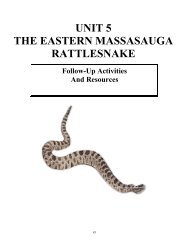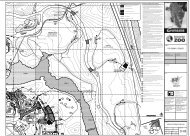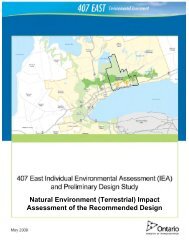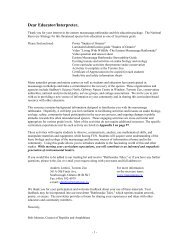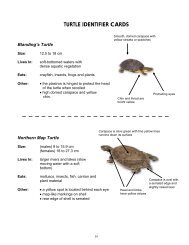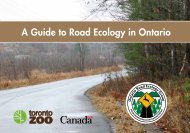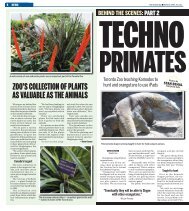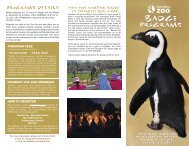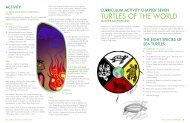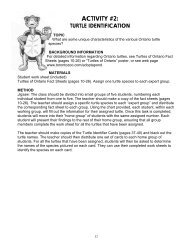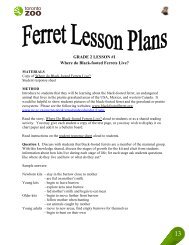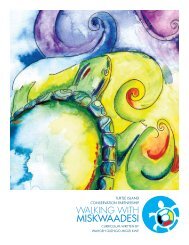Wetland Ecology Concerns Of Today - Toronto Zoo
Wetland Ecology Concerns Of Today - Toronto Zoo
Wetland Ecology Concerns Of Today - Toronto Zoo
You also want an ePaper? Increase the reach of your titles
YUMPU automatically turns print PDFs into web optimized ePapers that Google loves.
Newsletter of the Adopt-A-Pond<br />
<strong>Wetland</strong> Conservation Programme<br />
www.torontozoo.com/adoptapond<br />
Vol. 21 No. 2 ISSN 1705-8228 Autumn 2011<br />
<strong>Wetland</strong> <strong>Ecology</strong> <strong>Concerns</strong> of <strong>Today</strong><br />
Wind Turbines and Species at Risk<br />
Jody Marks<br />
Conservation Assistant, Adopt-A-Pond Programme<br />
Now, more than ever, issues such as preserving<br />
the natural environment and making "greener"<br />
choices are at the top of many communities'<br />
priority lists. When it comes to decisions about<br />
developing lands versus letting natural<br />
landscapes persist, the options are not always<br />
straight forward and the potential alternatives<br />
are not always obvious. The issue can become<br />
even more complex when a seemingly 'green'<br />
development initiative requires lands to be<br />
altered and appears to compete with other<br />
important aspects of the environment.<br />
Such is the case with a proposal made by the<br />
Gilead Power Corporation, a wind energy<br />
company that submitted a 2011 tender to the<br />
government of Ontario to construct a 9-<br />
turbine wind energy farm at Ostrander Point in<br />
Prince Edward County, Ontario - an area<br />
known to provide habitat for a number of<br />
In this Issue<br />
Wind Turbines & Species at Risk…………. pg 1-3<br />
Turtles on the Road (Jennifer Howard)… pg 4-5<br />
Snakes Need Shelter Too…………………... pg 6<br />
Chytridiomycosis and Frogs……………….. pg 7<br />
From Tadpole to Frog - Book Review……. pg 8<br />
species at risk animals, including the<br />
threatened Blanding’s turtle.<br />
http://pointtopointpec.ca<br />
Ostrander Point lies within the Ostrander<br />
Crown Land Block owned by the Ontario<br />
Ministry of Natural Resources (MNR). It is<br />
located just west of the Prince Edward Point<br />
National Wildlife Area, near the eastern end of<br />
Lake Ontario. The location proposed for the<br />
Ostrander Point Wind Energy Park is near the<br />
centre of the globally significant Prince<br />
Edward County South Shore Important Bird<br />
Area and only a few kilometres from the<br />
Prince Edward Point National Wildlife Area –<br />
the only National Wildlife Area specifically<br />
designated for its importance to migrating<br />
landbirds. This Important Bird Area (IBA) is<br />
designated as such because it is used by a
high concentration of landbirds during<br />
migration, as well as waterfowl.<br />
In 2004 the MNR made a policy decision to<br />
make some of its Crown land assets available<br />
for “green energy” projects. Such a policy<br />
change was intended to make the way easier<br />
for small, independent electricity generating<br />
projects to take place in central and northern<br />
Ontario, where much of the land is owned by<br />
the Crown. The policy change also opened up<br />
the playing field for wind energy developers,<br />
but it was not accompanied by efforts to<br />
systematically identify areas where wind<br />
energy projects should be excluded, as is<br />
currently the case with offshore turbines.<br />
Organizations such as Nature Canada, along<br />
with Ontario Nature and the Prince Edward<br />
County Field Naturalists, have publicly<br />
opposed Gilead’s<br />
application for a permit<br />
under<br />
Ontario's<br />
Endangered Species Act<br />
that would allow Gilead to<br />
“kill, harm or harass”<br />
endangered species like<br />
the Blanding’s turtle in<br />
Ostrander Point to pave<br />
the way for a wind energy<br />
plant. Those against the<br />
project’s development<br />
believe that Gilead’s Ostrander Point Wind<br />
Energy Park has the potential to “kill high<br />
numbers of migratory birds, permanently<br />
damage a significant breeding bird<br />
community, damage the wetland habitat of<br />
Blanding's turtles, and jeopardize the<br />
government’s responsibility for protecting<br />
Ontario’s biodiversity.”<br />
http://quinteconservation.ca<br />
Ted Cheskey, Nature Canada's manager of<br />
bird conservation has released a statement on<br />
the issue, declaring that, “Nature Canada<br />
along with its partners Ontario Nature and the<br />
Prince Edward County Field Naturalists agree<br />
climate change poses one of the greatest risks<br />
to biodiversity. We fully support the Ontario<br />
government’s intention to expand the use of<br />
clean and renewable sources of energy<br />
through its Green Energy and Green Economy<br />
Act. However, in responding to climate<br />
change, we must not sacrifice biodiversity and<br />
significant habitats. Protecting wildlife,<br />
threatened species and their habitat is vitally<br />
important if we are to buffer the effects of<br />
climate change and provide options for<br />
wildlife that must cope with predicted<br />
changes.”<br />
There are many concerns for the animals that<br />
live in the significant and diverse habitats on<br />
Ostrander Point. The Blanding’s turtle is<br />
threatened because of high levels of nest<br />
predation by skunks, foxes and coyotes, as<br />
well as increased traffic on roadways that<br />
intersect important habitats. Because<br />
Blanding’s turtles are attracted to gravel<br />
roadsides as nest sites, there is concern that<br />
roads built to facilitate construction of a wind<br />
farm will aggravate the risk of road mortality in<br />
the area substantially.<br />
Predation of nests is always<br />
a factor that influences the<br />
health of Blanding’s turtle<br />
populations. If predators<br />
within the new wind farm<br />
area (i.e. coyotes, red<br />
foxes, raccoons) use the<br />
new access roads to<br />
navigate through the<br />
habitat, Blanding’s turtles<br />
that lay their eggs in newly tilled soils along the<br />
edges of the access roads may be at higher<br />
risk of nest predation. Potential direct impacts<br />
may also arise from increased access and<br />
awareness of the local Blanding’s turtle<br />
population, resulting in hunting and poaching<br />
for the pet trade.<br />
There are organizations such as Friends of the<br />
Wind and community members that are in<br />
support of this project and they view green<br />
energy, specifically in the form of wind<br />
turbines, as a positive initiative. It could be<br />
argued that the Blanding's turtle population<br />
will adapt and even benefit from the restricted<br />
access gravel roads that will be built if the<br />
project proceeds. The roads that the turbines<br />
require for maintenance are restricted from<br />
public use and it therefore could potentially<br />
2
provide safer alternatives to nesting sites with<br />
public access, more pets, etc.<br />
adjusted to avoid adverse impacts to species<br />
during the active season.<br />
http://www.zephyrwind.com/wind_energy.html<br />
The positive side to recognizing all of these<br />
concerns and potential risks is that decisions<br />
can be made to change aspects of the<br />
project so that implementation can possibly<br />
be less invasive. For example, proposed<br />
construction windows have already been<br />
Some other concerns have been addressed<br />
and "reasonable' alternatives have been<br />
considered to reduce or eliminate impacts to<br />
the Whip-poor-will and its habitat and<br />
Blanding's turtles. Gilead Power Corporation<br />
has stated that "The Ostrander Point Wind<br />
Energy Park was designed to be sensitive to<br />
the wildlife of the area. That means that<br />
[Gilead] will construct at times least disruptive<br />
to existing wildlife. Once operational, the<br />
Ostrander Point Facility will employ some of<br />
the most aggressive mitigation measures in<br />
North America to protect local and migratory<br />
species."<br />
The revised proposal and approval of this<br />
project is still in progress. Environmental<br />
Assessments are currently being conducted to<br />
determine potential impacts and solutions.<br />
* The above article was researched and written using multiple sources. Some sources include Gilead Power, Nature Canada, and Wind<br />
<strong>Concerns</strong> Ontario. For a complete list of sources please contact Adopt-A-Pond at aap@torontozoo.ca.<br />
The<br />
Great Canadian Shoreline Clean-Up<br />
On September 23 rd , 2011 staff and volunteers from the <strong>Toronto</strong> <strong>Zoo</strong> and community<br />
members living near Rouge Park participated in the Loblaw Great Canadian<br />
Shoreline Cleanup, collecting litter and debris from the West Rouge Marshes and<br />
the Lake Ontario shoreline. Shoreline litter threatens wildlife and harms the health of<br />
ecosystems. Every September Canadians from across the country head to their<br />
local shorelines to make a positive impact in their community. Adopt-A-Pond<br />
coordinates a clean-up every year and you can create one in your community<br />
too! For more information on how to get involved visit: http://shorelinecleanup.ca/<br />
Carol Fysh, volunteer, cleaning the<br />
shoreline of the Rouge Marshes<br />
3<br />
Adopt-A-Pond staff with Bobbers the Blanding’s Turtle,<br />
one of the many species that lives in the Rouge Marshes
Turtles on the Road<br />
Jennifer Howard – Innisfil, ON<br />
I am a naturalist/photographer and the VP<br />
of The Six Mile Lake Conservationist Club. In my<br />
position I do hands on work combined with<br />
educational initiatives in the Six Mile Lake<br />
area. Turtles are an important focus in our<br />
club's work. Ontario has 8 native species of<br />
turtles and 7 of them are listed as species at<br />
risk.<br />
Turtles are amazing little creatures. Something<br />
that is so spectacular about them is their<br />
ability to survive at the bottom of freezing cold<br />
ponds during the winter months. A turtle's brain<br />
“shuts down” its body during hibernation, but is<br />
still aware of its surroundings. This same<br />
characteristic becomes a downfall if ever a<br />
turtle is struck on a road because the brain<br />
can still recognize pain for a short while after<br />
the heart has stopped. Turtles sometimes<br />
survive being hit by a car and that’s why it is so<br />
important not to ignore a turtle when you see<br />
it on the road, even if it looks dead.<br />
My husband, Mark, saw a turtle on the side of<br />
the road one day that had been hit by a car.<br />
The turtle was lying on its back unable to right<br />
itself because of its injuries. Most likely the turtle<br />
would have died, not due to its injuries, but<br />
from starvation and/or predation. By being<br />
stuck on its back the turtle was not able to eat<br />
and became an easy prey target for animals<br />
such as raccoons.<br />
I have seen many great Blue Herons eat<br />
smaller turtles and I have even found an<br />
empty turtle shell in a Great Horned Owl’s<br />
nest. Turtles have many predators, and like<br />
everything else in nature, they are an<br />
important part of the food chain. But for this<br />
particular turtle, it was not yet time.<br />
When Mark brought the injured turtle home<br />
we immediately made a call to the Kawartha<br />
Turtle Trauma Centre (KTTC). The centre<br />
operates as a hospital for injured wild turtles<br />
with help from dedicated staff and volunteers.<br />
Talking to the KTTC, we decided that the<br />
turtle's condition was stable enough to keep<br />
her at our house overnight. She spent the night<br />
in a container in our bathtub cradled softly on<br />
a warm, moist towel. The container was<br />
surrounded by a big, fluffy fleece blanket so<br />
that it was raised off of the cold tub. She did<br />
well over night and I was greeted by an alert<br />
and perky turtle in the morning. With the help<br />
of my good friend Fran, we were off by 6:30<br />
am the next morning to the KTTC.<br />
Kawartha Turtle Trauma Centre<br />
Sue Carstairs (right) and Jennifer Howard<br />
examining the rescued Painted turtle at KTTC.<br />
The turtle was admitted by Olivia<br />
Vandersaden, and Sue Carstairs, the medical<br />
director, took over from there. They gave the<br />
turtle a quick examination and found a crack<br />
in her shell that I had missed; this one would<br />
take longer to heal. She had a chunk missing<br />
from her carapace and a crack under the<br />
same area on her plastron. She also suffered<br />
from a long fracture on her side. Sue<br />
predicted she would need to stay at KTTC until<br />
spring 2012, but that afterwards she can return<br />
to the natural habitat where she was found.<br />
Ontario Turtle Tally and<br />
Frogwatch Appreciation Day is<br />
November 19, 2011. We look<br />
forward to having our<br />
participants join us for a day filled<br />
with information seminars and<br />
great stories!!<br />
4
Jennifer Howard<br />
The injury to the<br />
turtle's plastron<br />
The injury to the<br />
turtle's carapace<br />
Jennifer Howard<br />
You too can help save a turtle. If you see a<br />
turtle on a road please take the time to move<br />
the turtle away from danger. Make yourself a<br />
good "turtle kit" to keep in your car. Some<br />
important items to have in your kit would be<br />
rubber gloves or a shovel to help you move or<br />
pick up the turtle, a mid-sized tupperware<br />
container with holes punched in the lid or a<br />
light towel to throw over the turtle to keep it<br />
calm if it needs to be transported to a<br />
rehabilitation facility. It is very important to<br />
ALWAYS move a turtle across the road in the<br />
same direction that it was intending to go. This<br />
ensures that the turtle is not thrown off its<br />
journey, becoming disoriented and possibly<br />
ending up back on the road. Another tip is to<br />
keep a notepad and pen in your kit so you<br />
can record information about where you<br />
found the turtle and its condition. This<br />
information is useful and will help make certain<br />
that the turtle, when recovered, is returned to<br />
its proper habitat. Another great thing that<br />
you can do to help turtles is to report your<br />
sightings to Ontario Turtle Tally. Ontario Turtle<br />
Tally is a program run through Adopt-A-Pond<br />
at <strong>Toronto</strong> <strong>Zoo</strong>. You can visit the website for<br />
more information and help contribute to their<br />
great efforts for turtle and wetland<br />
conservation:<br />
www.torontozoo.com/AdoptAPond<br />
Mainly female turtles are brought to the KTTC.<br />
This is because females like to lay their nests in<br />
the soft, well-drained gravel shoulders of<br />
roads, and this puts them at risk for being<br />
struck by a vehicle. However, males are also<br />
struck during seasonal migrations and are<br />
equally vulnerable to road mortality in areas<br />
where roads intersect wetlands. It is up to us to<br />
help protect turtles on roads. A great initiative<br />
being adopted by some communities is the<br />
installation of turtle crossing signs. If you see a<br />
turtle crossing sign along the side of the road,<br />
please respect it. The sign is there because<br />
that location is a known "hotspot" for turtle<br />
crossings. Slow down and be a little more<br />
cautious in these areas. Our female turtle was<br />
lucky, but many others aren’t as fortunate.<br />
Mark and I are incredibly grateful to the KTTC.<br />
They do amazing work. They have extremely<br />
dedicated volunteers and staff, and they are<br />
very important for the survival of our native<br />
turtle populations. The KTTC even suggests<br />
that people deliver dead turtles to the centre<br />
because they may contain eggs that the<br />
centre can incubate and save. All of the<br />
volunteers and veterinarians that work at the<br />
KTTC give 110% when helping the turtles that<br />
come into their care. The centre is always in<br />
need of donations, especially this year.<br />
Unfortunately, much needed funding did not<br />
come through despite the fact that they have<br />
already treated more than 140 turtles in 2011.<br />
If you would like to help; become a member,<br />
buy a t-shirt or donate anything you can. To<br />
learn more visit: www.kawarthaturtle.org. For<br />
turtles in need of help please contact the<br />
Centre directly at (705) 741-5000.<br />
Jennifer Howard<br />
The "Lucky Girl"<br />
Note: As of today the turtle we rescued is still<br />
at the KTTC. She has since laid 8 eggs. Mama<br />
and babies are doing very well. Not just 1<br />
turtle life saved, but 9!<br />
5
Snakes Need Shelter Too!<br />
Rava Lee, Snake Biologist, Adopt-A-Pond<br />
In urban Ontario, there's not much room to<br />
grow. That’s especially true for our struggling<br />
snake populations. As development brings<br />
them in closer contact with humans, many are<br />
suffering from misinformed persecution and<br />
habitat fragmentation.<br />
Ontario is extremely lucky to have seventeen<br />
fascinating species of snakes. They come in an<br />
array of sizes, colours and patterns, and they<br />
all share the same shy and mellow<br />
temperament. Snakes are essential in local<br />
ecology; they balance pest populations like<br />
rodents and insects and are a food source for<br />
other predators.<br />
By providing appropriate habitat on your<br />
property you're helping to compensate for the<br />
loss of habitat that has devastated snake<br />
populations for over 100 years. Be sure to read<br />
up on which snakes live in your area to learn<br />
what habitat is most suitable for the species<br />
you’re interested in attracting.<br />
Some snakes like the Blue Racer and Queen<br />
snake only live in one isolated region in<br />
Ontario, and are rarely found in more<br />
urbanized areas. If you have a lake or stream<br />
on your property you're probably already<br />
attracting Northern Water snakes. Adding a<br />
buffer of cattails and marsh plants, however,<br />
can provide preferred habitat for snakes like<br />
the Eastern Ribbon snake, Eastern Fox snake<br />
and Black Rat snake, who like to supplement<br />
their diet of rodents with frogs. If you live in a<br />
region with Black Rat snakes, try looking up in<br />
the trees. These snakes are excellent climbers<br />
and often climb trees in search of birds or<br />
eggs.<br />
One of the most effective ways to attract<br />
snakes is to keep your grass long. Snakes hide<br />
and hunt in taller grass; mowed lawns do not<br />
afford snakes protection from predators and<br />
they also provide no prey. Starting a stone<br />
garden or adding rocky outcrops will also<br />
attract snakes for basking and protection.<br />
Snakes like to hide under wooden boards, in<br />
leaf litter and debris, and in barns and older<br />
buildings with stone foundations.<br />
Photo: Mandy Karch<br />
Milksnake (Lampropeltis triangulum)<br />
If you find a snake, remember not to pick it up<br />
or harass it. Snakes are wild animals and may<br />
inadvertently be injured by inexperienced<br />
hands. They will also defend themselves if they<br />
feel cornered. Snakes always prefer to flee<br />
rather than bite, but will bite if they feel<br />
threatened, so make sure to give your new<br />
friends space and respect.<br />
What we are doing:<br />
One species the <strong>Toronto</strong> <strong>Zoo</strong> and Rouge<br />
Park are especially concerned with is the<br />
Eastern Milksnake. A species with bright<br />
iridescent scales, large eyes and a<br />
flickering pink tongue, these snakes have<br />
been the victim of increasing road<br />
casualties. In addition, because of their<br />
patterning they are often mistaken for the<br />
Massasauga Rattlesnake, though the<br />
Massasauga is only found in a few<br />
isolated populations throughout Ontario.<br />
Milksnakes are not poisonous and are shy<br />
by nature, active mostly during dawn and<br />
dusk. In 2011, the Adopt-a-Pond<br />
Programme initiated a Milksnake survey<br />
project in Rouge Park in response to a<br />
number of snakes sighted dead on roads.<br />
The project will continue in 2012, and will<br />
help to understand Milksnake distribution<br />
and movement patterns in the Park.<br />
6
Chytridiomycosis and<br />
Frogs<br />
Jody Marks<br />
Conservation Assistant, Adopt-A-Pond<br />
What is it?<br />
In 1999 a new species of chytrid fungus<br />
was described that infects the skin of<br />
amphibians. It was named<br />
Batrachochytrium dendrobatidis or<br />
“Bd” for short.<br />
<br />
Chytridiomycosis is the disease that<br />
occurs when an amphibian is infected<br />
with large numbers of the Bd fungus.<br />
How does it kill amphibians?<br />
Chytridiomycosis causes an infection inside of<br />
the cells of the outer skin layers and causes<br />
the skin to become very thick.<br />
<br />
<br />
<br />
These changes in the skin are deadly to<br />
amphibians because they “drink” water<br />
and absorb important salts<br />
(electrolytes) through their skin in<br />
addition to what they take in through<br />
their mouth.<br />
Abnormal electrolyte levels cause the<br />
heart to stop beating and can cause<br />
death of the animal.<br />
Amphibians use their skin to breathe.<br />
Skin changes due to chytridiomycosis<br />
can interfere with this function, causing<br />
suffocation.<br />
How does it spread?<br />
<br />
<br />
http://www.costaricapages.com<br />
Panama’s Golden<br />
frog suffered<br />
extreme<br />
population losses<br />
possibly because<br />
of<br />
Chytridiomycosis<br />
Bd can spread from place to place<br />
through water, moist or wet materials or<br />
on the skin of infected amphibians.<br />
In the natural environment Bd can<br />
move on people’s boots or equipment<br />
7<br />
<br />
<br />
or on birds and invertebrates that travel<br />
between watersheds.<br />
Many amphibians that are infected<br />
with Bd are resistant to the disease<br />
chytridiomycosis, but they are still<br />
capable of spreading Bd from one<br />
location to another.<br />
Amphibians can also move Bd to new<br />
locations as a result of trade in bait<br />
shops or pet stores, or potentially by the<br />
release of captive amphibians to the<br />
wild.<br />
What are the signs of chytridiomycosis?<br />
<br />
<br />
Some of the most common signs are<br />
reddened or otherwise discolored<br />
skin, excessive shedding of skin,<br />
abnormal postures, unnatural<br />
behaviors, or seizures.<br />
Many of these signs are said to be<br />
“non-specific” and many different<br />
amphibian diseases have signs that<br />
overlap with those of chytridiomycosis.<br />
For these reasons it is not possible to<br />
diagnose chytridiomycosis with the<br />
naked eye. Laboratory testing is<br />
required.<br />
What can you do?<br />
<br />
<br />
<br />
http://www.bloomberg.com<br />
The Mountain<br />
Yellow-legged<br />
frog species is<br />
endangered by<br />
chytridiomycosis<br />
It is not currently possible to eradicate<br />
chytrid fungus from wild amphibian<br />
populations. It is also unfeasible to<br />
protect a natural wilderness area prior<br />
to the arrival of chytrid fungus.<br />
We recommend that you do not<br />
purchase amphibians unless you are<br />
certain they were captive-bred in<br />
disease-free conditions and raised<br />
locally.<br />
It is very important not to move frogs or<br />
tadpoles from one habitat area to<br />
another.
From Tadpole to Frog<br />
- Book Review -<br />
Written by: Wendy Pfeffer<br />
Illustrated by: Holly Keller<br />
Reviewed by: Jody Marks, Conservation<br />
Assistant, Adopt-A-Pond<br />
Wendy Pfeffer is the author of several titles in the Let's-<br />
Read-and-Find-Out Science series. In this book she<br />
describes the incredible metamorphosis from tiny,<br />
jellylike egg, to little fishy tadpole, to great big bullfrog.<br />
Wendy has written this story in a way that it is<br />
scientifically correct but fun and understandable for<br />
children as young as age 5. The book captivates and<br />
holds the attention of the reader throughout its 32<br />
pages due, in large part, to the beautiful illustrations<br />
drawn by Holly Keller.<br />
Holly Keller is the illustrator of more than thirty-five<br />
books for young children. In this book she has created<br />
the conventional frog pond; we observe life in it<br />
through the seasons as the tadpoles grow legs and<br />
lungs and eventually hop onto land as fully grown<br />
bullfrogs. The illustrations compliment the text very<br />
effectively, helping to explain the process of<br />
metamorphosis and demonstrating the frenzy of<br />
activity in a pond above and below the water level<br />
during each stage of a frog's life.<br />
Volume 21, No. 2<br />
Amphibian Voice is distributed to schools<br />
and community members participating in<br />
the Adopt-A-Pond programme. The<br />
purpose of this newsletter is to provide<br />
information on amphibian, turtle and<br />
wetland conservation issues in Ontario.<br />
Send in your stories, drawings and<br />
photographs to the address below and<br />
we will happily include them in future<br />
issues.<br />
Editors:<br />
Julia Phillips<br />
Adopt-A-Pond Coordinator<br />
Bob Johnson<br />
Curator of Amphibians & Reptiles<br />
Contributors:<br />
Jody Marks<br />
Jennifer Howard<br />
Rava Lee<br />
Autumn 2011<br />
Support for the Adopt-A-Pond<br />
Programme:<br />
- Environment Canada's Habitat<br />
Stewardship Program<br />
- Ontario Ministry of Natural Resources<br />
Species at Risk Stewardship Fund<br />
- <strong>Toronto</strong> <strong>Zoo</strong> Endangered Species<br />
Fund<br />
- Rouge Park Natural Heritage Fund<br />
Adopt-A-Pond is a non-profit wetland<br />
conservation and education programme.<br />
Costs to produce this newsletter, and<br />
other resources, are funded by grants and<br />
private donations.<br />
We welcome support of our programme!<br />
Please make cheques payable to<br />
“<strong>Toronto</strong> <strong>Zoo</strong>” and send them to the<br />
following address. Thank you!<br />
http://www.harpercollinschildrens.com<br />
Publisher: Harper Collins Publishers<br />
Paperback ISBN: 9780064451239<br />
Paperback Cover Price: $5.99<br />
Adopt-A-Pond<br />
<strong>Toronto</strong> <strong>Zoo</strong><br />
361A Old Finch Ave.<br />
<strong>Toronto</strong>, ON M1B 5K7<br />
Phone: 416-392-5999<br />
Fax: 416-392-4979<br />
aap@torontozoo.ca<br />
8



